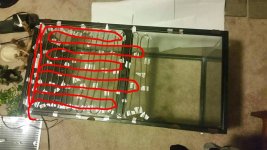Leopard Gecko Care
To view click Leopard Gecko Setup, not the arrow: Updates to video
1. ===> No plain calcium, calcium with D3, or multivitamins inside a vivarium <===
2. Best to buy stuff individually rather than getting a 10 gallon set up kit.
3. Avoid cedar,
pine,
willow, or
fir bark in reptile enclosures. Cedar fumes and oils are highly toxic to reptiles; pine fumes and oils are toxic as well!
4. Quarantine Recommendations
- Any new gecko should be quarantined for a minimum of 90 days prior to introducing her/him to the other geckos in the same cage. That gives adequate time to check for parasites, cryptosporidia, and the beginnings of coccidia plus. 3-6 months of quarantine are recommended if your new gecko is imported or wild caught.
- The quarantine area should be in a separate room apart from your established geckos. Stringent sanitation methods MUST be followed!
5. Occupant(s) - Best to house leos alone. Leos do not benefit from companions or “friends”.
- Never keep 2 males together. They will seriously fight!
- Even 2 similarly sized females can fight.
6. Enclosure - Consider a 20 gallon LONG vivarium (30 inches long x 12 inches deep x 12 inch tall) a
minimum "forever" home" for one 70 gram leo. That's 76 cm x 31 cm x 31 cm. Get the largest enclosure you can afford.
7. Heating - Your Under Tank Heat mat (UTH) should be
1/2 the length of the enclosure's ground and reach from side to side of the enclosure. One of two dry hides and the moist hide should sit right on top of the UTH.
Your leopard gecko will be more active if you provide an UTH for belly heat/digestion as well as an overhead dome with a Ceramic Heat Emitter to warm the air. Then your leo benefits from a "warm zone", not only a "warm spot". The UTH and the CHE both belong on the warm end of the tank. The UTH and the CHE each require separate thermostats since the settings will be different.
- If you have a 10 gallon enclosure, use Zoo Med's 8 x 12 inch UTH (or maybe the 6 x 8 inch) UTH.
- If you have a 20 gallon LONG: 30 x 12 x 12 inches, use an 11 x 17 inch UTH. The 11 x 17 inch will not compromise cool end temperatures. Another GU member does this and still gets 76*F for her cool end. Both Fluker's and Ultratherm make this size.
- Use heat cables to customize heating when standard size UTHs don't cover the total width and half the length.
8. Substrate - Good choices: rough textured ceramic, porcelain, or slate tiles. Paper towels also work. Add paper towel layers to poop spot to facilitate clean up.
- I do NOT recommend these particulate substrates: calci-sand, ground walnut shell, sand, Eco Earth's coco fiber, bark chips, aquarium gravel, peat moss, et cetera. The risk of impaction is simply not worth it. After you have had successful experience caring for leos, there are other options. In that case ALL husbandry needs to be spot on!!!
- If you use tile, you will discover the backsides of tiles have ridges. In order to avoid "hot spots" on the tile's surface, place a thin layer of well-washed play sand underneath the tiles.
9. Temperatures - A temperature gradient from warm to cool maintains your leo's health.
Here's a temperature guide for all leopard geckos as measured with the probe of a digital thermometer (and controlled by a thermostat set at 91*F/32.8*C):
- 88-92 F (31.1-33.3 C) ground temperature right underneath a leo's warm dry hide
- no greater than 82ish F (27.8ish C) air temperature - 4 inches above ground on the warm end
- no greater than 75 F (23.9 C) air temperature - 4 inches above ground on the cool end
Leave the UTH on 24/7. At night turn off overhead lighting/heating (~12 hours on and ~12 hours off) unless ambient room temperatures drop lower than 67ish*F (19.4*C).
10. Use a digital thermometer's probe to measure air temps and ground temperatures. Temperature guns are excellent for measuring surface temperatures. A stainless steel aquarium-type thermometer that has been verified can also be used.
11. Lighting (photoperiod lighting) - To better meet the
crepuscular needs of leopard geckos
- Place a low wattage bulb (15 watt standard incandescent bulb) dimmed to half power inside a 5.5 inch diameter fixture in the center of the screen top and right next to the CHE bulb.
- Vary the on-time monthly of both the CHE and the photoperiod bulb according to this Pakistan link. For example, 11 hours ON in February is good.
- Click: Sunrise Sunset Daylight Hours of Pakistan -- Timebie
12. UVB lighting is recommended for leopard geckos
ONLY IF there is adequate space and opportunities for the leopard gecko to dodge some of the rays like in a 4.5 foot x 2 foot x 2 foot vivarium.
A 48 inch long vivarium is a suggested minimum for using UVB for leopard geckos. Never use UVB lighting in addition to a powdered vitamin D3 supplement!
13. Buy a thermostat! A thermostat will control your under tank heater and/or overhead Ceramic Heat Emitter, provide your leopard gecko with stable and comfortable temperatures, save $ on electricity, and lessen the chance of a house fire from accidental overheating. Tape the probe of a reliable digital thermometer to the thermostat's probe to verify the thermostat's setting.
- Hydrofarm’s Jump Start MTPRTC thermostat is quite satisfactory. The Jump Start MTPRTC has a digital readout and a small metal probe. It's accurate to 1.0*F.
- Inkbird’s digital thermostat is also good. It has sockets for two devices kept at the same temperature.
- Apollo thermostats have good ratings. Amazon cost = $20.
14. 3 hides are needed per leo: warm DRY, warm MOIST, cool DRY. Keeping one hide
warm and moist 24/7 is very important!
Both warm hides should sit on top of the UTH. The warmth from your UTH helps generate the required humidity. Leopard geckos use their warm moist hides for hydrating even when not shedding.
 15. Supplements
15. Supplements
Dusting a "wee pinch" of
Zoo Med's Reptivite multivitamins without vitamin D3 on the feeders @ ONLY 1 feeding per week is what my vet suggests. Then also dust feeders with
Zoo Med's Repti Calcium with vitamin D3 @ 1 other feeding per week.
For leos 18 months old and older, and for leos 12 months old and older who are in good shape:
- Monday---lightly dust most all the feeders with Zoo Med's Repti Calcium with D3
- Thursday---lightly dust most all the feeders with Zoo Med's Reptivite multivitamins without D3
For leos 0 - 12 mo, please refer to post 124 on my Geckos Unlimited Leo Care Sheet.
16. Too much vitamin D3 and/or calcium is as bad as too little vitamin D3 and/or calcium. Rep-Cal’s Calcium with D3 contains
17x more D3 than does Zoo Med’s Repti Calcium with D3.
17. Diet
- Like humans, geckos are what they eat. A huge factor in the husbandry of any gecko is to feed the feeders (crickets, worms, et cetera) a high quality diet 24/7. A variety of feeders is important! Nutritious feeder bodies transfer like nutrients to your geckos. "Light supplemental dusting" of these feeders equals a "sprinkling of powdered sugar upon a cake".
- Vary the diet: crickets, roaches, hornworms, grasshoppers, silkworms, mealworm pupae, freshly molted mealworms, black soldier fly larvae (Phoenix, repti, calciworms), and locusts (smallest locusts possible).
- Feed insects and worms a high quality dry diet like finely ground Zoo Med's Natural Adult Bearded Dragon Food with high calcium/low phosphorus veggies on the side like collard greens.
- If you decide to use poultry food to feed insects and worms, ONLY use the following brands. Other brands contain diatomaceous earth!
- Albers' All Purpose Poultry Feed OR
- Purina Layena Sunfresh Crumbles
18. There are few benefits to feeding waxworms on a regular basis. Those worms are extremely high in fat. If your leo needs to gain weight, feed more of the healthier feeders. Phoenix worms, hornworms, and/or silkworms provide excellent variety. They provide nutrition as well as moisture.
19. Urates should be white, not yellow, and approximately 1/3 the size of the feces. A healthy feces is dark brown and about the size and shape of 2 tic tacs.
20. Consider covering 3 sides of your leopard gecko's enclosure with something like brown paper bags or construction paper to provide privacy.
21. Helpful links












